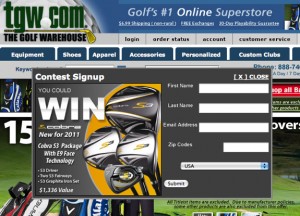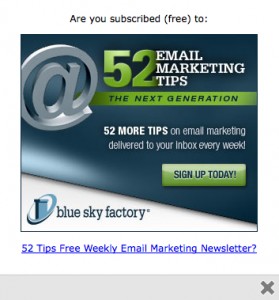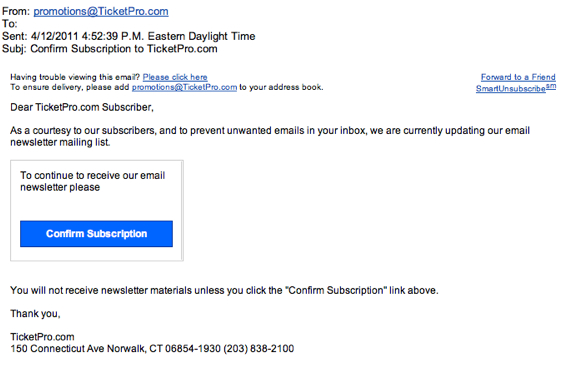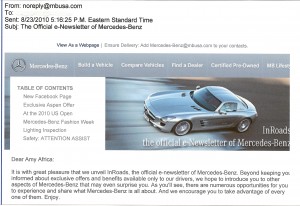I got a lot of emails about last week’s post, Five Low-Cost Things You Should Be Doing Today To Improve Your Email Program. Most of the questions and comments were about mobile emails and if/how they are different.
First things first…
For many companies, the majority of mobile traffic is being generated because of email. Thrust, trigger and ad hoc campaigns are being opened on handhelds. When the customer clicks through the email, they get your site, whether it’s mobile-friendly or not.
If you do not want your email traffic to hit your site on a mobile device, send out your emails when your users are LESS likely to open them on a handheld.
Can you really do that? Yes, of course. You can send your thrust (aka spray-and-pray or blast) emails out whenever you’d like. Some providers grumble about it. Others make you pay extra for “preferred time of day blasts.” But depending on the state of your mobile-readiness, it might be worth it for you.
With many providers, you can also segment your file based on which device your users are most likely to open your email on. Please note: The providers who shun this are typically the ones who haven’t figured out a way (or can’t) do it. Having an email provider who understands your business and doesn’t just dump you into their cookie-cutter mold is now more important than ever.
But I digress…
Time of day is important for other mobile-email stuff too.
Take your abandoned cart emails, for example. Are you sending out your campaigns at a time of day when the user is most likely to convert over the phone or on the desktop? Are you sending out a slightly different version of your email(s) when someone abandons on a handheld device vs your desktop site? (Hint: You should be testing/doing both.) Mobile abandons are skyhigh right now and that’s not likely to change dramatically anytime soon. To get the biggest bang for your marketing buck, you should pay close attention to what you’re sending where – and when.
Another thing to consider? One of the biggest issues with abandoned cart marketing is driving the user back to the exact place where they failed. (One of the many reasons why I like to push people to the phone if you can.) One of the newest (and even more annoying-to-the-consumer) issues is pushing abandoners to a device where their cart is “missing.” And yes, this can happen even if you have a responsive site as this has more to do with cookies, security, and such. Both issues are workaroundable but you’ve got to develop the strategy and then execute it.
What else do you need to know about mobile email?
Here are 16 proven tips to help you make your mobile email program a success.
Pay close attention to your subject lines. You have fewer characters (about 12-15ish is ideal even though 32-45ish fits) to make an impact. Use them wisely. You should also look at whether or not highly promotional subject lines work for you mobile-wise – are your immediate deletions increasing? If so, it’s most likely because of what you’re doing in your From, Subject Line, and/or first line of your email. (Please note: Your From Address is REALLY important too.)
Don’t underestimate your preheaders. A lot of marketers use preheaders as, well, an afterthought. It’s unfortunate because preheaders can be very useful, especially when it comes to mobile. Write them like a 70-character elevator pitch for the email you’re about to showcase. Incidentally, there are many consultants who think preheaders are a waste of space and recommend you eliminate them on all mobile emails. Preheaders are NOT for unsubscribe messaging nor are they going to work for weak-ass statements that mean little/nothing to the user. In other words, use them aggressively or not at all.
Action directives are critical. There should be one for every view. If you have TMM (too much money), or are under the delusion that you’re Apple and only want to use one call-to-action per email, make sure you put it on the first view. People scroll but we’re top heavy when it comes to where we put our attention. (This is a brain thing.) Make sure to leave extra wiggle room (at least 10 px) around ALL your action directives. (This extra-space thing is key for all things mobile and too often underestimated.)
If you have a call center, promote the hell out of your phone number. Let’s face it, right now it’s probably much easier for a user to push a click-to-call button than it is for them to maneuver your mobile checkout. Not to mention you can upsell/cross-sell on the phone easily – it’s much more difficult to do it on a handheld device. Get your folks to the phone where you can.
Less is more. File size is important. Period. Gmail and other folks cut stuff off at specific file sizes (like 102 kb, for example) so you’ve really got to pay attention to your file sizes and how you prioritize your emails. (Incidentally, this is one of the reasons why I mentioned that you should be top-heavy – because if you save important stuff to the end, it may not ever get seen.)
Give some extra love to your visuals. The number of visuals, their size and how you present them is a key factor in your success. Stick to images less than 250ish px wide. Remember, a lot of devices default to “images off” so your email needs to make sense WITHOUT the images. (Note: Yes, you can use 300 px wide but remember if you put a 300px+ image in your email(s) – especially at the top – you are likely going to end up with a frightening block of white space.)
Use your colors wisely. What looks good on a desktop often doesn’t look the same on a handheld. Rule of thumb: your emails should not look like the Easter Bunny’s basket.
Fonts matter. You can get away with a lot in the desktop world that you can’t on a handheld device. Use simple, standards fonts. Headline sizes should be 22 points (I prefer larger but large fonts can impact your deliverability so use them with caution) and body copy should be at 12 pts or greater. Yes, some folks recommend 11 pts – having tested this a lot, I can say that 90% of the time I’ve seen 13 and 14 work better – it really has to do with how many emails your user is reading on their handhelds and what they’re doing when they are reading them.
Eleventy bazillion scrolls? That won’t help you either. Preview your emails on a handheld – don’t just dump them into a responsive template and think you’re done with it. Determine how many scrolls your email is and where it loses efficacy (you can use link tracking to help you with this.)
Single column mobile emails usually work best. Not always but most of the time. These days, most providers recommend you keep the width of your templates to 600 px or less. (I concur with that and think you should keep another 20 px for clearance on each side.) Again, this is highly dependent on your user and their ease/comfort with their mobile inbox. One of the best things about single column templates is that they render well across most browsers.
Be careful with the social media icons. Sometimes they are useful but often times, when tested in mobile emails, they decrease overall conversion and sales. If you don’t want someone to get lost in their Facebook or Twitter accounts, you need to be careful.
Limit your links. I recently heard a well-known industry consultant say that you should only have two links in mobile emails – one for the unsubscribe link and one for everything else. I don’t agree with this whatsoever but I do recommend that you keep your links to a minimum on all emails. That doesn’t mean you should only have 3, it means use your links as if your job depended on getting x number of clicks on each one.
Speaking of links, don’t stack them. Chubby fingers need clearance. I realize this sounds like a throwaway point but a lot of folks dump every link under the sun on the bottom of their emails and/or their sites. It’s just NOT A GOOD IDEA on mobile anything.
Minimize the vomit. Too often, companies let their Customer Service and Legal departments throw up all over sites and emails. Sadly, this often results in a War and Peace puking of fine print all over the bottom of things – this is not good in the desktop world but it’s a terrible, horrible, no good, very bad thing in the mobile world. Bottom line: keep the blithering to a minimum.
“DO NOT REPLY” typically doesn’t work with mobile customers. I know. I know. But there are a lot of companies who still use this in their “from” address and all over their emails so it needs to be said.
Keep the unsubscribe links/buttons away from anything else of value. In the desktop world, over half the people unsubscribe by mistake (or because there aren’t other good choices for things like changing their email address.) Unfortunately, that number is proving out to be much greater in the mobile world. So put your unsubscribe and preference center links in there but keep them away from the valuable stuff.
Have a question or tip you’d like to add? Email it to info@amyafrica.com.











 You always ask that question to other people so now I ask you, ARE YOU SMOKING CRACK? You told my boss that we shouldincrease the number of e-mails we send out? You were joking, right? You know our company. We can barely do one e-mail every other week and now you want us to dosix times that? SHOOT ME NOW.”
You always ask that question to other people so now I ask you, ARE YOU SMOKING CRACK? You told my boss that we shouldincrease the number of e-mails we send out? You were joking, right? You know our company. We can barely do one e-mail every other week and now you want us to dosix times that? SHOOT ME NOW.”